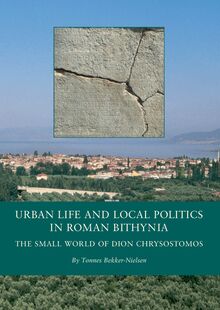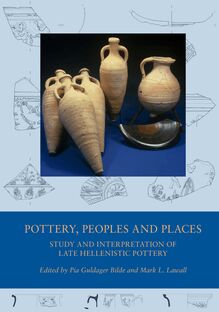-
 Univers
Univers
-
 Ebooks
Ebooks
-
 Livres audio
Livres audio
-
 Presse
Presse
-
 Podcasts
Podcasts
-
 BD
BD
-
 Documents
Documents
-
- Cours
- Révisions
- Ressources pédagogiques
- Sciences de l’éducation
- Manuels scolaires
- Langues
- Travaux de classe
- Annales de BEP
- Etudes supérieures
- Maternelle et primaire
- Fiches de lecture
- Orientation scolaire
- Méthodologie
- Corrigés de devoir
- Annales d’examens et concours
- Annales du bac
- Annales du brevet
- Rapports de stage
La lecture à portée de main
388 pages
English
Découvre YouScribe en t'inscrivant gratuitement
Je m'inscrisPottery, Peoples and Places , livre ebook
Découvre YouScribe en t'inscrivant gratuitement
Je m'inscris
Obtenez un accès à la bibliothèque pour le consulter en ligne
En savoir plus
En savoir plus
388 pages
English
Obtenez un accès à la bibliothèque pour le consulter en ligne
En savoir plus
En savoir plus

Description
The late Hellenistic period, spanning the 2nd and early 1st centuries BC, was a time of great tumult and violence thanks to nearly incessant warfare. At the same time, the period saw the greatest expansion of Hellenistic Greek culture, including ceramics. Papers in this volume explore problems of ceramic chronology (often based on evidence dependent on the violent nature of the period), survey trends in both production and consumption of Hellenistic ceramics particularly in Asia Minor and the Pontic region, and assess the impact of Hellenistic ceramic culture across much of the eastern Mediterranean and into the Black Sea.
Sujets
Informations
| Publié par | Aarhus University Press |
| Date de parution | 14 mai 2014 |
| Nombre de lectures | 0 |
| EAN13 | 9788771244243 |
| Langue | English |
| Poids de l'ouvrage | 16 Mo |
Informations légales : prix de location à la page 0,2300€. Cette information est donnée uniquement à titre indicatif conformément à la législation en vigueur.
Extrait
POTTERY, PEOPLES AND PLACES STUDY AND INTERPRETATION OF LATE HELLENISTIC POTTERY
Edited by Pia Guldager Bilde and Mark L. Lawall
POTTERY, PEOPLES AND PLACES
This page is protected by copyright and may not be redistributed
BLACK SEA STUDIES
16
THE DANISH NATIONAL RESEARCH FOUNDATION’S CENTRE FOR BLACK SEA STUDIES
This page is protected by copyright and may not be redistributed
POTTERY, PEOPLES AND PLACES
S῝ῌῡ ῌ I῍ῚῘῚ῍ῑῗ ῗ῎L῍ H῍῍ῑΊῑΉ Pῗ῍Ὶῡ
Edited by Pia Guldager Bilde and Mark L. Lawall
AARHUS UNIVERSITY PRESS
This page is protected by copyright and may not be redistributed
POTTERY, PEOPLES AND PLACES
© Aarhus University Press and the authors 2014 Cover design by Narayana Press Front cover photos: Amphoriskoi, jug and plate from Kedesh exca-vations: Berlin, Herbert and Stone, Fig. 9. Background: proïles of mouldmade bowls from Mesambria and Apollonia, A. Petrova.
Ebook production Narayana Press, Gylling
ISBN 978 87 7124 424 3
AARHUS UNIVERSITY PRESS Langelandsgade 177 DK-8200 Aarhus N
White Cross Mills Lancaster LA1 4XS England
70 Enterprise Drive Bristol, CT 06010 USA
www.unipress.dk
The publication of this volume has been made possible by generous grants from the Aarhus University Research Foundation
Danish National Research Foundation’s Centre for Black Sea Studies University of Aarhus DK-8000 Aarhus C www.pontos.dk
This page is protected by copyright and may not be redistributed
Preface
C
O
N
Pia Guldager Bilde and Mark L. Lawall Introduction
Pà 1. Côôôîéŝ
T
E
N
T
S
Nathan Badoud The Contribution of Inscriptions to the Chronology of Rhodian Amphora Eponyms
M.L. Lawall, P. Guldager Bilde, L. Bjerg, S. Handberg, J.M. Højte The Lower City of Olbia Pontike Occupation and Abandonment in nd the 2Century BC
Sarah James Bridging the Gap: Local Poery Production in Corinth 146‑44 BC
Guy D. R. Sanders, Yuki Miura & Lynne Kvapil A Re‑examination of some of the South Stoa Wells at Corinth
Susan I. Rotro Sulla and the Pirates
Pà 2. Tôô
Christine Rogl Mouldmade Relief Bowls from Ephesos – The Current State of Research
Nina Fenn The Hellenistic Mouldmade Bowl Production at Priene – A Case Study Concerning the Reception of Ephesian Examples
This page is protected by copyright and may not be redistributed
1
7
9
5
17
29
47
65
83
111
113
141
6 Contents Patricia Kögler nd Table Ware from Knidos: The Local Production during the 2 and st 1centuries BC
Georg Lomtadze & Denis Žuravlev Hellenistic Poery from the Necropolis of Olbia Pontike
Anelia Bozkova West Slope Poery from Mesambria Pontike
Aneta Petrova A Pontic Group of Hellenistic Mouldmade Bowls
Vasilica Lungu & Pierre Dupont Imports and Local Imitations of Hellenistic Poery in the Northwest Black Sea Area: Hadra and Pseudo‑Hadra Wares
Denis Žuravlev & Natalia Žuravleva Late Hellenistic Poery and Lamps from Pantikapaion: Recent Finds
Valentina V. Krapivina Late Hellenistic Red‑Slip Ware in Olbia
Pà 3. Céàîçŝ à CUUé
John Lund Pots and Politics: Reections on the Circulation of Poery in the Ptolemaic and Seleukid Kingdoms
Andrea Berlin, Sharon Herbert, and Peter Stone Dining In State: The Table Wares from the Persian-Hellenistic Administrative Building at Kedesh
Jean-Paul Morel Les campaniennes A et B, deux aspects d’une ‘globalisation’ économique et culturelle des céramiques tardo‑hellénistiques
Bibliography Index List of Contributors
This page is protected by copyright and may not be redistributed
157
175
199
215
233
255
287
295
297
307
323
337 371 385
Preface
The papers in this volume were delivered at a conference held in 2008. In the intervening years, the editors’ scholarly eorts were oen distracted by other projects. This is a common enough occurrence, and in most cases the result-ing delays are simply regreable. In the present case, however, the delays meant that our colleague Pia Guldager Bilde was never able to see the ïnal results of her eorts. Pia passed away on January 10, 2013, aer a prolonged struggle with cancer. She knew that much progress had been made in editing the pres-ent volume; indeed, she had carried out the initial formaing and editing of many of the papers. The contributors to this volume, much like those of other volumes in the Black Sea Studies series, represent a coming together of Pontic and Aegean/Eastern Mediterranean scholars. The Sandbjerg conference epitomized the impact of Pia’s energy and determination to break down the linguistic, cultural, political and academic divisions that had so long isolated Pontic scholarship from the Greco-Roman mainstream. The Olbia project – the reason why I became involved with the organization of this conference and the editing of this volume – likewise demonstrated the depth and success of academic collaboration that could be achieved under Pia’s guidance. The contributors to this volume join me in expressing our deepest gratitude to Pia for bringing us all together. We have all lost a dear friend and guiding spirit.
Winnipeg, June 2013
CONTENTS INDEX This page is protected by copyright and may not be redistributed
Introduction
Pia Guldager Bilde and Mark L. Lawall
The papers published here were presented at a conference held at the Sandb-jerg Manor, Denmark, in late November 2008, focused on the study of ceram-nd ics in the Mediterranean and Pontic regions in the 2 century BC. The host of the conference, the Danish National Research Foundation’s Centre for Black Sea Study, was in the process of ïnalizing the manuscript on the Lower City nd excavation at Olbia Pontike where the 2 century BC was a period both of great activity and of signiïcant decline. Though not the only artefacts aesting to this tumultuous period of Olbia’s history, the ceramic remains provided, by far, the most compelling evidence for the chronological sequence of events and for the cultural contacts shaping Late Hellenistic life at Olbia. The Centre’s work at Olbia and the thriving network of scholars that developed around that work, whether working in the Pontic region or in the Aegean/Mediterranean worlds more generally, created the opportunity to open new discussion on nd the ceramic record of the Greco-Roman world of the 2 century BC. The resulting conference addressed three main themes: (a) chronologies; (b) production, distribution and inuence of selected ceramic types; and (c) broader socio-economic interpretations based on the ceramic record. Many of the papers ït neatly into one or another of these themes, so they fall eas-ily into place in this volume. Others address multiple themes; and some ele-ment of editorial decision was needed to align these papers with those most kindred to them within the volume. Indeed, it is very much in the spirit of the Sandjerg conference that papers whose primary focus is chronology or typology should also consider broader interpretive problems.
Chronology First, given recent advances in and critical reconsiderations of Hellenistic ar-tefact chronologies, the program included papers directly addressing chrono-logical ‘ïxed points’ and methodological considerations of how we build chro-nologies for ceramic types. In the ïrst paper in this section, Nathan Badoud provides a fundamental deconstruction of the past scholarship that built the Rhodian eponym chronology without sucient aention to the epigraphi-cal record of the island. The corrections he proposes here, based on closer aention to paerns in the Rhodian calendar and Rhodian prosopography, make clear earlier erroneous assumptions about larger groups of stamps with terminal dates as provided by destructions and abandonments. Even
CONTENTS INDEX This page is protected by copyright and may not be redistributed
-
 Univers
Univers
-
 Ebooks
Ebooks
-
 Livres audio
Livres audio
-
 Presse
Presse
-
 Podcasts
Podcasts
-
 BD
BD
-
 Documents
Documents
-
Jeunesse
-
Littérature
-
Ressources professionnelles
-
Santé et bien-être
-
Savoirs
-
Education
-
Loisirs et hobbies
-
Art, musique et cinéma
-
Actualité et débat de société
-
Jeunesse
-
Littérature
-
Ressources professionnelles
-
Santé et bien-être
-
Savoirs
-
Education
-
Loisirs et hobbies
-
Art, musique et cinéma
-
Actualité et débat de société
-
Actualités
-
Lifestyle
-
Presse jeunesse
-
Presse professionnelle
-
Pratique
-
Presse sportive
-
Presse internationale
-
Culture & Médias
-
Action et Aventures
-
Science-fiction et Fantasy
-
Société
-
Jeunesse
-
Littérature
-
Ressources professionnelles
-
Santé et bien-être
-
Savoirs
-
Education
-
Loisirs et hobbies
-
Art, musique et cinéma
-
Actualité et débat de société
- Cours
- Révisions
- Ressources pédagogiques
- Sciences de l’éducation
- Manuels scolaires
- Langues
- Travaux de classe
- Annales de BEP
- Etudes supérieures
- Maternelle et primaire
- Fiches de lecture
- Orientation scolaire
- Méthodologie
- Corrigés de devoir
- Annales d’examens et concours
- Annales du bac
- Annales du brevet
- Rapports de stage
Signaler un problème
YouScribe
Le catalogue
Le service
© 2010-2024 YouScribe









